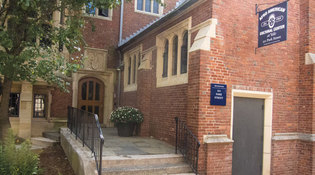 loading
loading
Light & VerityMore funds, renovations for cultural centersAfter an external review, a new commitment to Asian, Latino, Black, and Native American centers.  Mark Zurolo ’01MFAThe Afro-American Cultural Center is the oldest of four such centers that recently underwent an external review. View full imageWhen the announcement was made last December that the New York police officer who killed Eric Garner would not be indicted, Micah Jones ’16 knew where she needed to go: the Afro-American Cultural Center. “It was a space where I didn’t have to defend the humanity of [Garner and others] who had recently been killed,” Jones says. “And I didn’t have to defend my own humanity through that. It was a space where I was just a person who was hurting and whose hurt was recognized and valued and shared.” The Afro-American center, established in 1969, was the first of Yale’s cultural centers: meeting places where students can host events and explore their cultural identity. It is now one of four such centers, joined by the Asian American Cultural Center, the Native American Cultural Center, and the Latino Cultural Center, also known as La Casa Cultural. The centers have been the subjects of much scrutiny over the past year. Last year, the university commissioned a study by four outside educators on how to strengthen and improve the centers. In December, they published their recommendations, and the Yale administration responded with a commitment to increased funding. Also, new directors were appointed for all but the Asian American center. Among the key recommendations was the need to improve the physical infrastructure of the Asian American center and La Casa, two buildings that the university is now rehabilitating. The report also recommended allowing for student input on center directors, allocating more resources for the centers, reinforcing organizational structure, and increasing student engagement. While they welcomed the changes, a number of students involved with the centers expressed concern that the administration and students have different ideas of the centers’ mission. Elisia Ceballo-Countryman ’18, a member of the Afro-American center, says the administration has seen the centers “not as community places but as more like academic spaces.” Over the last several years, many students from the Afro-American center in particular felt it had lost touch with its roots of fostering student community. Last February, 147 students signed a petition calling for the center’s dean, Rodney Cohen, to step down; when he did so a month later, Yale College dean Jonathan Holloway ’95PhD cited “diverging visions” as the reason. Kim Clayton Hershman ’88, ’92JD, an alumna who has remained involved in the center, suggests that under Cohen’s leadership it had departed from its purpose as “a home space and a social space.” She adds, “Over a period of five years the center really moved away from that vision, and you have a generation of students that didn’t get that experience.” Kimberly Goff-Crews ’83, ’86JD, secretary and vice president for student life, who directed the Afro-American Cultural Center from 1992 to 1998, says the centers’ intellectual and social functions are not mutually exclusive. “I don’t think that they are either-or. They are both-and. And as we move forward, we’re going to try to figure out how to support that with the new team.”
The comment period has expired.
|
|